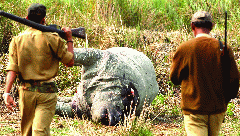Archives
issue
Kaziranga has been declared as a World Heritage Site by UNESCO and widely acclaimed as a successful conservation story the world over. KNP is home to almost 75 per cent of the world’s rhino population. Kaziranga is situated in the Bokakhat sub division of Golaghat district in Central Assam. Stretching over an area of 430 km KNP was declared a reserve forest in 1908 and elevated to a Game sanctuary in 1918. In 1950, KNP was turned in to a wild life sanctuary and in 1974 it was declared a National Park. UNESCO put a World Heritage site tag on it in 1985.
 The widespread concern has not come without a reason. According to the state Government, 650 one horned rhinos have been killed in Kaziranga in the past 40 years. Of that, 550 were killed by poachers between 1980 and 1997 alone-the highest being 48 in 1992. But there was a marked reduction in the killing between 1998 and 2006 when just 47 rhinos were killed . In fact, the number increased from 1,164 in 1993 to 1,855 in 2006. “The decline in killings was due to intensive security measures, better intelligence network, coupled with support from villagers living on the periphery of the park,’ disclosed Mr. Dharanidhar Boro, forest ranger of the Kaziranga National Park to Eastern Panorama.
The widespread concern has not come without a reason. According to the state Government, 650 one horned rhinos have been killed in Kaziranga in the past 40 years. Of that, 550 were killed by poachers between 1980 and 1997 alone-the highest being 48 in 1992. But there was a marked reduction in the killing between 1998 and 2006 when just 47 rhinos were killed . In fact, the number increased from 1,164 in 1993 to 1,855 in 2006. “The decline in killings was due to intensive security measures, better intelligence network, coupled with support from villagers living on the periphery of the park,’ disclosed Mr. Dharanidhar Boro, forest ranger of the Kaziranga National Park to Eastern Panorama.
While 18 rhinos were killed according to WTI, reports put the figure at 20 inside the park last year, compared to just five in 2006. Interestingly, the top management of the park was changed last year and this was the first time in a decade when the number of rhinos killed in the year touched a double digit figure. The UNESCO Heritage site is now facing one of its biggest crisis as this year, four pachyderms have been killed in a span of just five weeks.
While environmentalists attribute the sudden spurt in killings to the Government’s negligence and lax security system, one NGO has even claimed that there is a nexus between officials and poachers. A stinker was raised after cartridges of .315 rifles were found at the site where a female rhino and its calf were killed on January 19.
The Assam government has realised that it has to care more for the forest staff so that they are motivated to care for wildlife. A 12 member committee constituted by the government on poaching at Kaziranga National park, home to the world’s largest population of the critically endangered one horned rhino, has said that forest personnel manning the sanctuary must first feel secure to perform the arduous tasks assigned to them.
The recommendations in the 13-page report tabled by Forest Minister Mr. Rockybul Hussain in the Assembly on March 7 last include residential schools for children of employees, a 30-bed hospital, single-bedroom units at the range headquarters for transit accommodation and awards for bravery and commendable service. The report also makes a case for inducting “fresh legs” into the forest force. Kaziranga stretches over 859 square km and the available manpower is inadequate for a national park of this size. It hasn’t helped that a section of forest personnel is ageing and physically incapable of withstanding the rigours of patrolling and fighting poachers.
As many as 53 per cent of employees in Kaziranga are between 41 and 50 years of age and 14.6 per cent between 51 and 60. The report suggests that the government has to take a long, hard look at the age factor and transfer ageing personnel to less demanding workplaces.
Pranab Kumar Das

